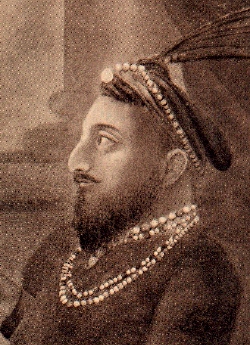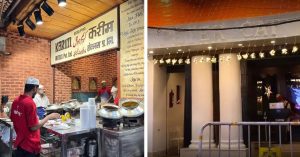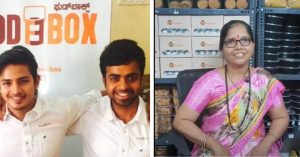Love, Betrayal & a Caged Tiger: The Intriguing Legend Behind Bakarkhani Bread
There's nothing quite like freshly baked bakarkhani with sweetened milk tea. Did you know this Mughal-era bread has a backstory that can put many Bollywood plot lines to shame?

Have you ever had a taste of crispy, spiced and thick layered flatbread called the Bakharkhani made in parts of Kolkata?
This particular variant of Bakarkhani bread, which some believe originated in present-day Bangladesh, has an incredible legend behind it.
According to Bangladeshi writer Nazir Hossain, who wrote Kingbodontir Dhaka, this particular delicacy was first brought to life by Aga Bakar Khan, an aristocrat who cooked it in memory of Khani Begum, a woman he loved (Bakar+Khani) but could never be with after a rival lover had her killed.
It’s an intriguing plot line.
Dated to the 18th century, the story essentially begins with two key protagonists who made their way to Murshidabad (then known as Mukhusabad in present-day Bangladesh).
There is Murshid Quli Khan, who would later go on to become the first Nawab of Bengal, and the man responsible for changing the name of the city to Murshidabad. The other protagonist was his protege, Aga Bakar Khan.
Born a Hindu in the Deccan circa 1670, Murshid Quli Khan was sold as a slave to a Persian noble who raised him as a Muslim. The noble even gave him the name Muhammed Hadi.
After travels through Persia, Hadi returned to India, working under the Diwan of Vidarbha, circa 1698. It was his skill in handling matters of public administration that caught the eye of the infamous Mughal emperor Aurangzeb, who promoted him as the first Diwan of Bengal just two years later.
During his journey back from Persia, Hadi, who had changed his name to Murshid Quli Khan, brought along his young protege, Aga Bakar Khan. Under Murshid’s watchful eye, Aga Bakar received training in administration, hand-to-hand combat and military strategy. Besides these skills, young he had also become an astute scholar in Persian and Arabic.
Murshid first deputed the young protege to Chittagong, commanding the military garrison there, before becoming its Diwan.
There, young Aga Bakar fell in love with Khani Begum, a courtesan of exquisite beauty from the Arambagh area of Dhaka. However, the local police chief, Jainul Khan, also had his eyes set on this beauty.

Capturing Khani Begum, the police chief lured Aga Bakar to rescue her. Moments after Aga Khan ‘rescued’ her, he ran into Jainul and his police team. It was a trap. While Jainul managed to escape the scene, locals were led to believe that the couple had him killed.
Convinced that Aga Bakar had Jainul killed, the court of Murshid Quli Khan, the Nawab of Bengal, sentenced him to death despite the lack of witnesses and evidence. The death sentence was to be carried out in the cage of a hungry tiger.
However, in a plot twist straight out of the Colosseum of ancient Rome, Aga Bakar managed to kill the tiger and emerged a free man.

Unfortunately, during his absence from the outside world, Jainul returned to kidnap and eventually murder Khani Begum.
Upon hearing this news, Aga Bakar was left devastated. In circa 1742, he eventually settled in Barisal district of present-day Bangladesh in an area subsequently named after him, Bakarganj.
During his time in the city, Bakarganj had become an important stop for traders from Persia, Armenia and even Kashmir. A passionate baker, Aga Bakar came up with a special recipe of flatbread and named it after the love of his life. Known also as Bakorkanhi, this flatbread recipe has long survived the man.
Following his death in 1754, the bread made its way through present-day Bangladesh, West Bengal, and even Hyderabad and Kashmir. As it made its way through various geographies and cultures, different elements were incorporated.
Today, Bakarkhani is a very popular flatbread in Kashmir. While some believe it was first introduced to Kashmiri traders in Bakarganj, there is no documentary evidence to support this.

“As the Bakakhani travelled, it also evolved. In some parts, it is a circular flatbread stuffed with cheese, dry fruit or sweet semolina, while in others, it is made with clarified butter or ghee, and it even looks and tastes like [a] biscuit in other places,” says this fascinating article in Live History.
Also Read: Craving Pomfret? Let This Award-Winning Scientist Tell You How To Eat Fish Responsibly
However, reports contend that this bread is going out of fashion, and one can only find it in parts of Kolkata, Dhaka, Chittagong, Lucknow, and even Patna, and only during the month of Ramadan.
It’s very difficult to trace the exact historical roots of food, particularly bread, which can be found in many parts of the world. But this is too good a story not to recite.
(Edited by Shruti Singhal)
Like this story? Or have something to share? Write to us: [email protected], or connect with us on Facebook and Twitter.
This story made me
- 97
- 121
- 89
- 167
Tell Us More
We bring stories straight from the heart of India, to inspire millions and create a wave of impact. Our positive movement is growing bigger everyday, and we would love for you to join it.
Please contribute whatever you can, every little penny helps our team in bringing you more stories that support dreams and spread hope.



















